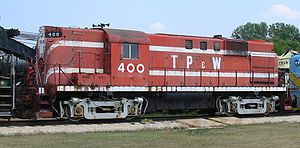ALCO RS-11
ALCO RS-11

|
| Type and origin |
| Power type |
Diesel-electric |
| Builder |
ALCO, MLW
|
| Model |
RS-11 |
| Build date |
February 1956 to June 1961 (Alco) / April 1964 (MLW) |
| Total produced |
425 |
|
|
|
| Performance figures |
| Power output |
1,800 hp (1,300 kW) |
| Tractive effort |
64,325 lb (29,177 kg) |
|
|
|
| Type and origin |
| Power type |
Diesel-electric |
| Builder |
ALCO, MLW
|
| Model |
RS-11 |
| Build date |
February 1956 to June 1961 (Alco) / April 1964 (MLW) |
| Total produced |
425 |
| Performance figures |
| Power output |
1,800 hp (1,300 kW) |
| Tractive effort |
64,325 lb (29,177 kg) |
The ALCO RS-11 is a diesel-electric locomotive of the road switcher type rated at 1,800 hp (1.34 MW), that rode on two-axle trucks, having a B-B wheel arrangement.
The first three RS-11s were produced by ALCO in February 1956 as a demonstrator set. This locomotive, classified by ALCO as model DL-701, was their first high-horsepower road switcher, intended to be a replacement for the very popular RS-3 road switcher. Featuring a V-12, 1,800 hp (1,300 kW) 251B diesel engine, the RS-11 was ALCO's answer to EMD's very successful GP9. The turbocharged RS-11 accelerated faster, had a higher tractive effort rating and typically used less fuel than the competition. It was also quite versatile and could be found in heavy haul freight as well as passenger service. It was produced in high-nose and low-nose versions. Montreal Locomotive Works built identical units.
While the RS-11 benefited from the increased power and reliability offered with ALCO's new 251B engine, and was arguably a more advanced product than the GP9, its market acceptance was disappointing against the reputation EMD's locomotives had made for superior reliability.
...
Wikipedia

